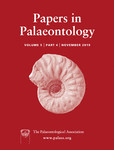Reg. Charity No. 1168330

A systematic revision of the temnospondyl ‘Metoposaurus’ azerouali Dutuit from the Late Triassic of the Argana Basin (Western High Atlas, Morocco) is presented. The type material is redescribed in detail, and a preliminary phylogenetic analysis – the first one dealing with all metoposaurid species – is also conducted in order to test its position within the Metoposauridae. Our analysis places ‘Metoposaurus’ azerouali as sister‐taxon to Arganasaurus lyazidi in a robust clade supported by two unambiguous synapomorphies (bulge‐like tabular horn and exoccipital process visible in dorsal view) and two ambiguous synapomorphies (cultriform process of uniform width and subtriangular posterior Meckelian fenestra). We therefore propose the new combination Arganasaurus azerouali comb. nov. for the species ‘M.’ azerouali. Our analysis also confirms that the central Laurasian genus Metoposaurus is monophyletic but not the genus Koskinonodon, which deserves its own systematic revision. By consequent, the Late Triassic rich vertebrate fauna from the Argana Basin comprises the metoposauroid Almasaurus habazzi, the basal metoposaurid Dutuitosaurus ouazzoui, and the genus Arganasaurus which is represented by the type species A. lyazidi and A. azerouali comb. nov. Combined with the stratigraphical and geographical occurrences of the taxa, our phylogenetic analysis suggests that metoposaurids may have appeared during the Longobardian (late Ladinian) in central Pangea. Their diversification may be linked to the Carnian Pluvial Episode. At least, their extinction may have occurred during the Rhaetian because of the aridification of the climate and/or competition with amniotes.